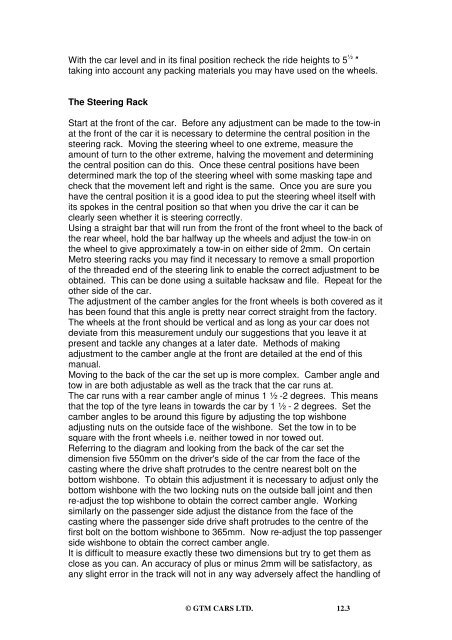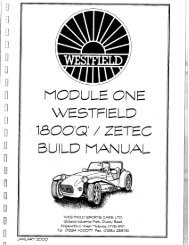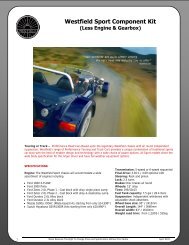You also want an ePaper? Increase the reach of your titles
YUMPU automatically turns print PDFs into web optimized ePapers that Google loves.
With the car level and in its final position recheck the ride heights to 5 ½ ″<br />
taking into account any packing materials you may have used on the wheels.<br />
The Steering Rack<br />
Start at the front of the car. Before any adjustment can be made to the tow-in<br />
at the front of the car it is necessary to determine the central position in the<br />
steering rack. Moving the steering wheel to one extreme, measure the<br />
amount of turn to the other extreme, halving the movement and determining<br />
the central position can do this. Once these central positions have been<br />
determined mark the top of the steering wheel with some masking tape and<br />
check that the movement left and right is the same. Once you are sure you<br />
have the central position it is a good idea to put the steering wheel itself with<br />
its spokes in the central position so that when you drive the car it can be<br />
clearly seen whether it is steering correctly.<br />
Using a straight bar that will run from the front of the front wheel to the back of<br />
the rear wheel, hold the bar halfway up the wheels and adjust the tow-in on<br />
the wheel to give approximately a tow-in on either side of 2mm. On certain<br />
Metro steering racks you may find it necessary to remove a small proportion<br />
of the threaded end of the steering link to enable the correct adjustment to be<br />
obtained. This can be done using a suitable hacksaw and file. Repeat for the<br />
other side of the car.<br />
The adjustment of the camber angles for the front wheels is both covered as it<br />
has been found that this angle is pretty near correct straight from the factory.<br />
The wheels at the front should be vertical and as long as your car does not<br />
deviate from this measurement unduly our suggestions that you leave it at<br />
present and tackle any changes at a later date. Methods of making<br />
adjustment to the camber angle at the front are detailed at the end of this<br />
<strong>manual</strong>.<br />
Moving to the back of the car the set up is more complex. Camber angle and<br />
tow in are both adjustable as well as the track that the car runs at.<br />
The car runs with a rear camber angle of minus 1 ½ -2 degrees. This means<br />
that the top of the tyre leans in towards the car by 1 ½ - 2 degrees. Set the<br />
camber angles to be around this figure by adjusting the top wishbone<br />
adjusting nuts on the outside face of the wishbone. Set the tow in to be<br />
square with the front wheels i.e. neither towed in nor towed out.<br />
Referring to the diagram and looking from the back of the car set the<br />
dimension five 550mm on the driver's side of the car from the face of the<br />
casting where the drive shaft protrudes to the centre nearest bolt on the<br />
bottom wishbone. To obtain this adjustment it is necessary to adjust only the<br />
bottom wishbone with the two locking nuts on the outside ball joint and then<br />
re-adjust the top wishbone to obtain the correct camber angle. Working<br />
similarly on the passenger side adjust the distance from the face of the<br />
casting where the passenger side drive shaft protrudes to the centre of the<br />
first bolt on the bottom wishbone to 365mm. Now re-adjust the top passenger<br />
side wishbone to obtain the correct camber angle.<br />
It is difficult to measure exactly these two dimensions but try to get them as<br />
close as you can. An accuracy of plus or minus 2mm will be satisfactory, as<br />
any slight error in the track will not in any way adversely affect the handling of<br />
© <strong>GTM</strong> CARS LTD. 12.3






